Table of Contents
- Introduction
- Editor’s Choice
- Global Meat Substitutes Market Overview
- Production Volume of Meat Substitutes
- Price of Meat Substitutes
- Leading Meat Substitute Brands Ranked by Brand Awareness
- Demographics of Plant-Based Meat Alternatives
- Consumption Pattern of Plant-Based Meat Alternatives
- Advances in Meat Substitute Production Technologies
- Challenges Faced by the Meat Substitutes Industry
Introduction
According to Meat Substitutes Statistics, Meat substitutes, made from plant proteins, fungi, or cultured cells, mimic the flavor and texture of traditional meats. Offered in diverse formats like burgers and sausages, they cater to dietary and ethical concerns.
Created through methods like extrusion and fermentation, these substitutes frequently tout better nutritional compositions with lower saturated fat and cholesterol levels.
Propelled by the growing demand for sustainable food choices, the meat substitute market garners investments from established players and up-and-coming businesses. Their versatility and environmentally friendly characteristics could revolutionize the food sector.
Editor’s Choice
- By 2033, the global meat substitutes market is forecasted to attain a revenue of USD 29 billion.
- In the distribution of meat substitutes, the food service sector dominates with a commanding market share of 76%, while the retail segment holds a notable but comparatively smaller share of 24%.
- The average revenue per capita of meat substitutes will rise to $2.09 in 2028.
- China leads the global meat substitutes market with a substantial revenue of USD 2.371 billion, followed closely by the United States at USD 2.06 billion.
- By 2028, production volume of meat substitutes is expected to reach 0.98 billion kilograms.
- Beginning at $15.06 in 2018, the price of meat substitutes slightly decreased to $14.16 in 2019 before remaining relatively stable at $14.10 in 2020.
- In 2023, MorningStar Farms and Beyond Meat emerged as the leading meat substitute brands in the United States, with 56% and 54% of respondents indicating awareness of these brands, respectively.

Global Meat Substitutes Market Overview
Global Meat Substitutes Market Size
- The revenue generated by the global meat substitutes market is anticipated to witness significant growth over the forecast period from 2023 to 2033 at a CAGR of 14.5%.
- Beginning at USD 3 billion in 2023, the market revenue is projected to increase steadily, reaching USD 4 billion in 2024 and USD 5 billion in 2025.
- By 2030, the market is forecasted to attain a revenue of USD 15 billion, followed by further substantial growth to USD 19 billion in 2031 and USD 23 billion in 2032.
- The upward trend persists, culminating in a projected revenue of USD 29 billion by 2033.
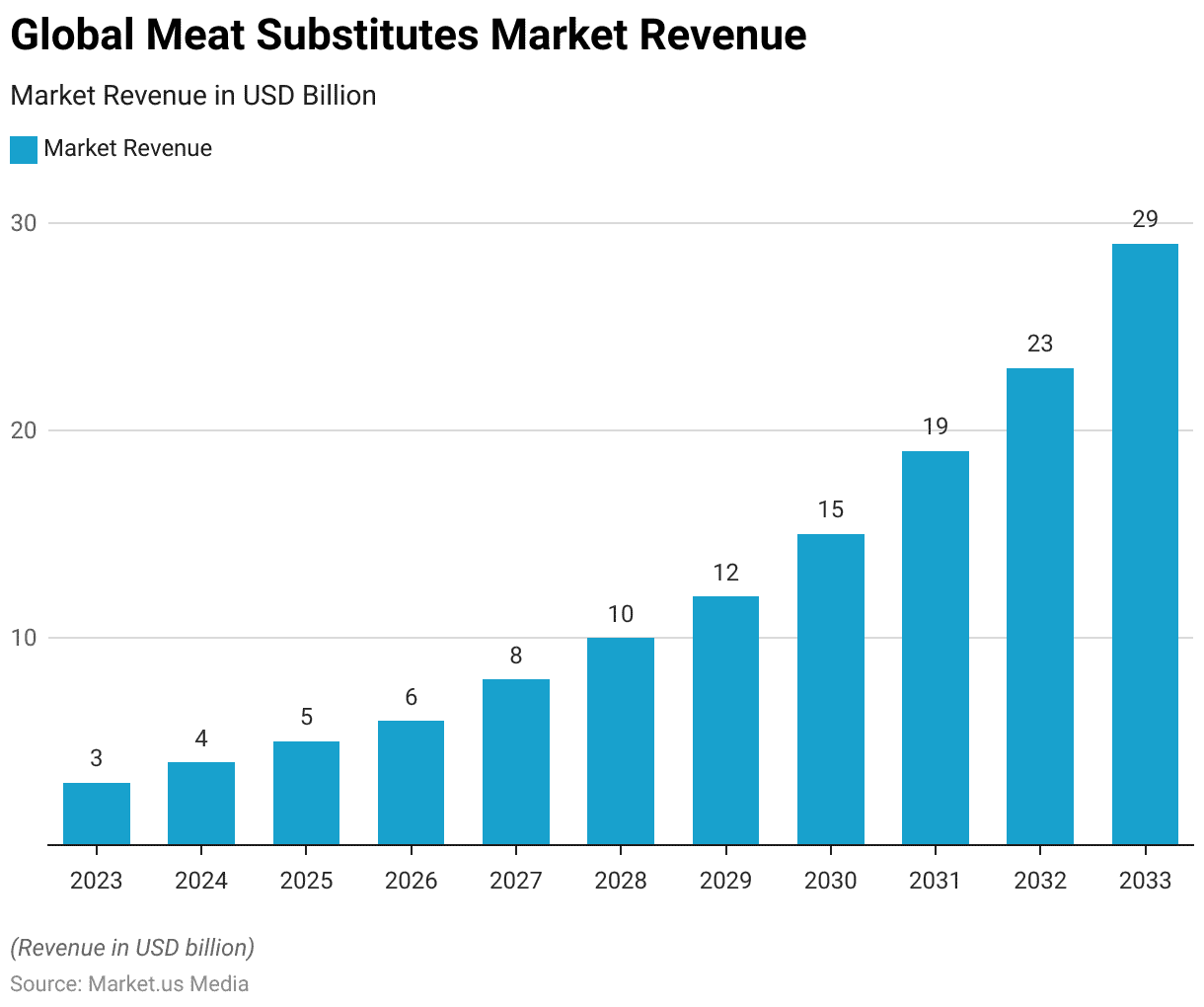
Meat Substitutes Market Share – By Distribution Channel
- In the distribution of meat substitutes, the food service sector dominates with a commanding market share of 76%, while the retail segment holds a notable but comparatively smaller share of 24%.
- This distribution underscores the significant presence of meat substitutes within the food service industry, which includes restaurants, cafeterias, catering services, and other establishments.
- Meanwhile, the retail segment, encompasses supermarkets, grocery stores, specialty food stores, and online retailers.
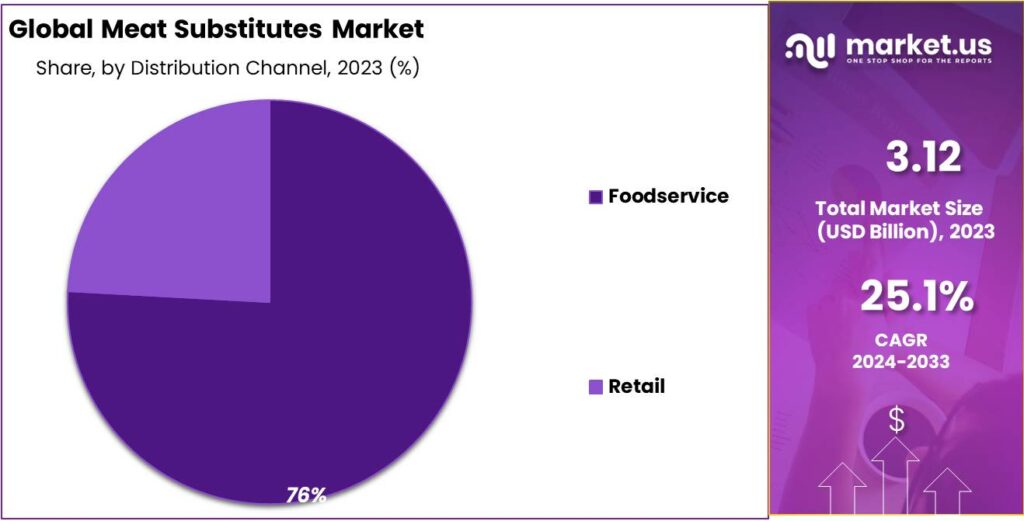
Average Revenue Per Capita
- The average revenue per capita of meat substitutes, denoted in USD, has consistently grown over the specified period.
- Beginning at $0.64 in 2018, the figure increased steadily to $0.73 in 2019 and $0.89 in 2020.
- This upward trend continued, with average revenues reaching $1.03 in 2021 and $1.18 in 2022.
- This trend persists, with average revenues of $1.78 in 2026, $1.93 in 2027, and $2.09 in 2028.
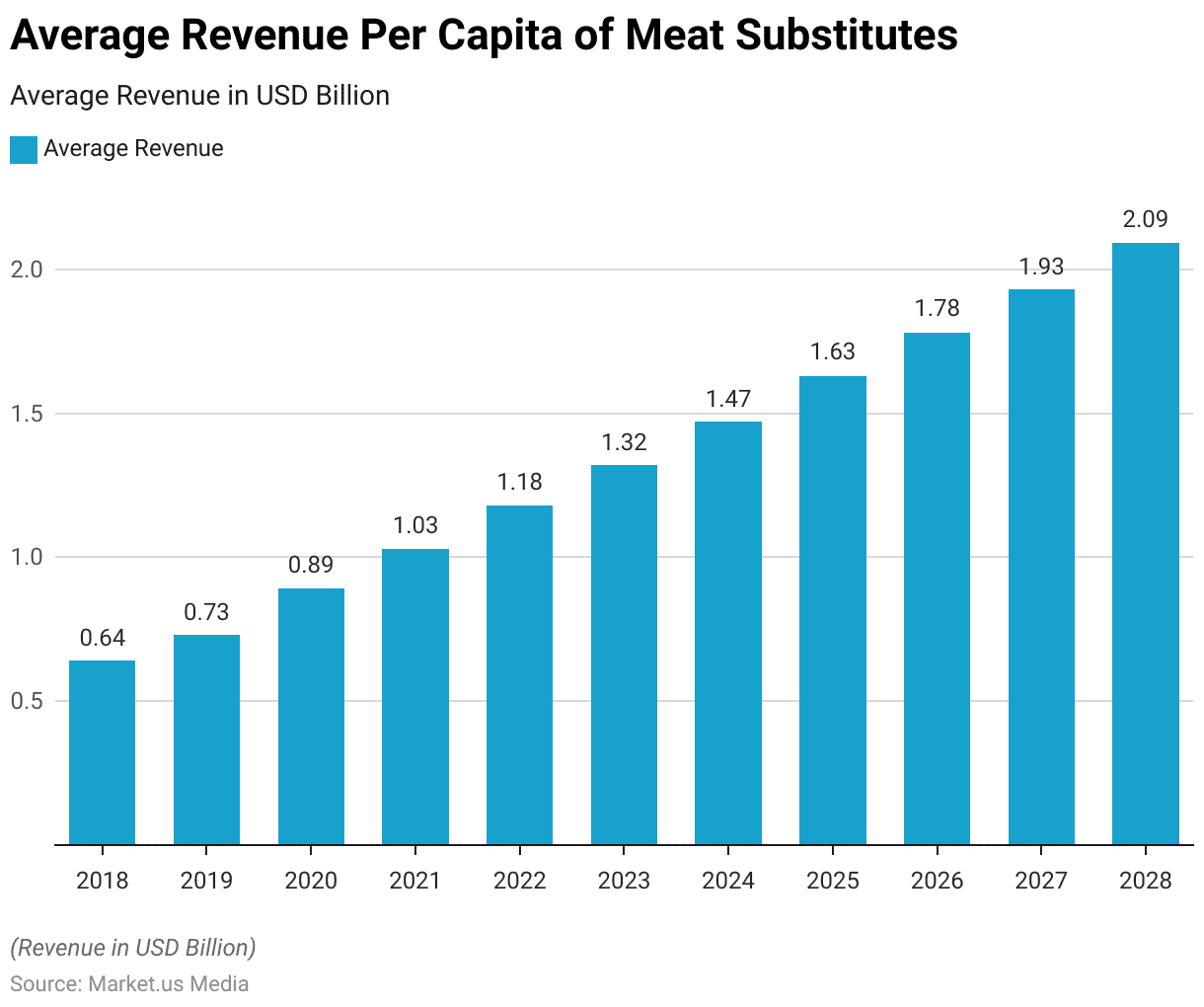
Regional Analysis of the Global Meat Substitutes Market
- China leads the global market with a substantial revenue of USD 2.371 billion, followed closely by the United States at USD 2.06 billion.
- The United Kingdom emerged as another significant market, with revenue totaling USD 1.106 billion.
- Russia and Germany follow with revenues of USD 776 million and USD 744 million, respectively, indicating a notable presence of meat substitutes in these European markets.
- The Netherlands and Japan contribute moderately to the global market with revenues of USD 358 million and USD 323 million, respectively.
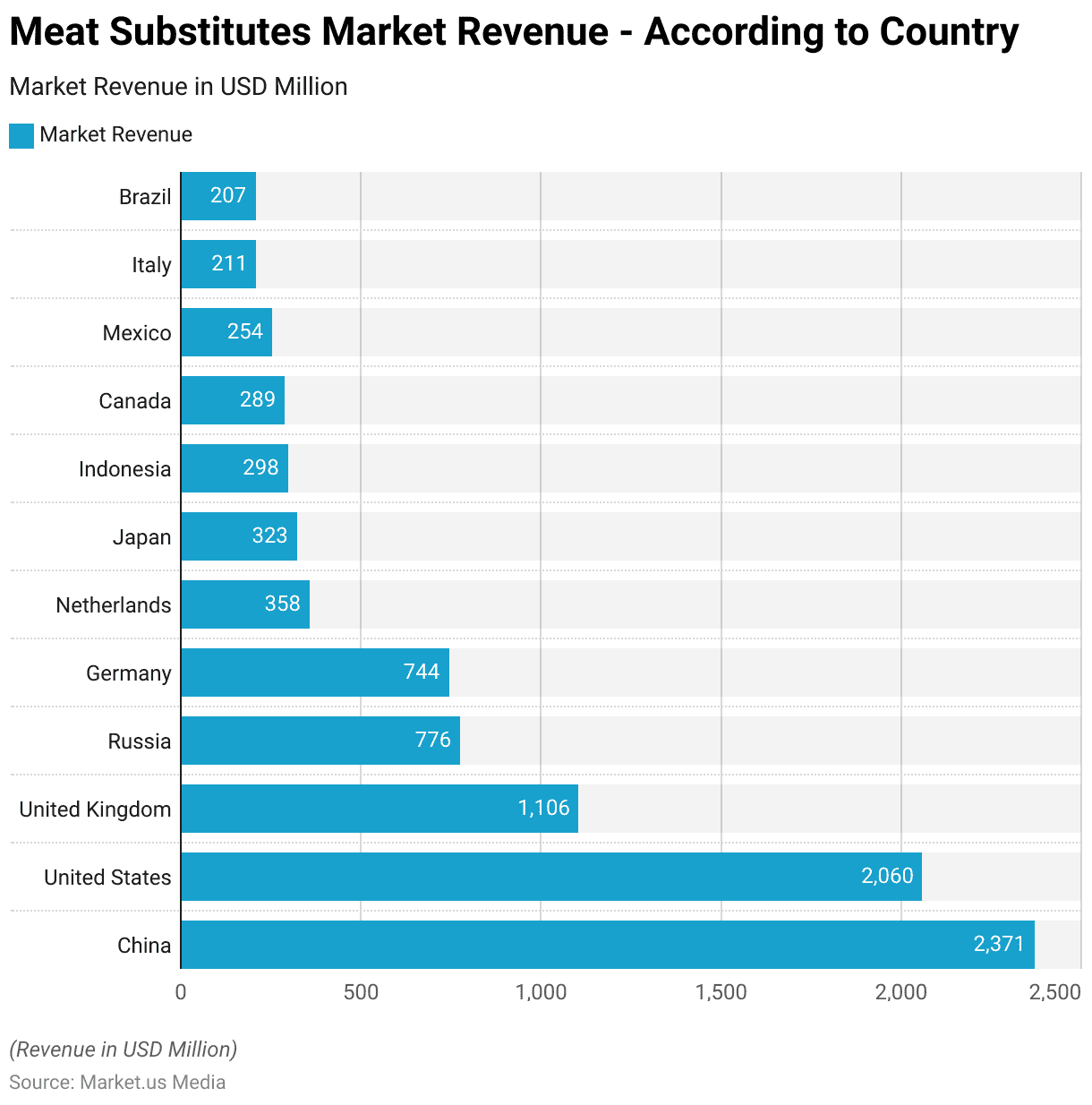
Production Volume of Meat Substitutes
- The production volume of meat substitutes has shown a consistent upward trend over the years, reflecting increasing consumer demand and technological advancements in plant-based protein manufacturing.
- Starting at 0.31 billion kilograms in 2018, the production volume has steadily risen yearly, reaching 0.38 billion kilograms in 2019 and 0.47 billion kilograms in 2020.
- The trend of growth persists, with forecasted production volumes of 0.79 billion kilograms in 2025, 0.86 billion kilograms in 2026, and 0.92 billion kilograms in 2027.
- By 2028, production is expected to reach 0.98 billion kilograms.
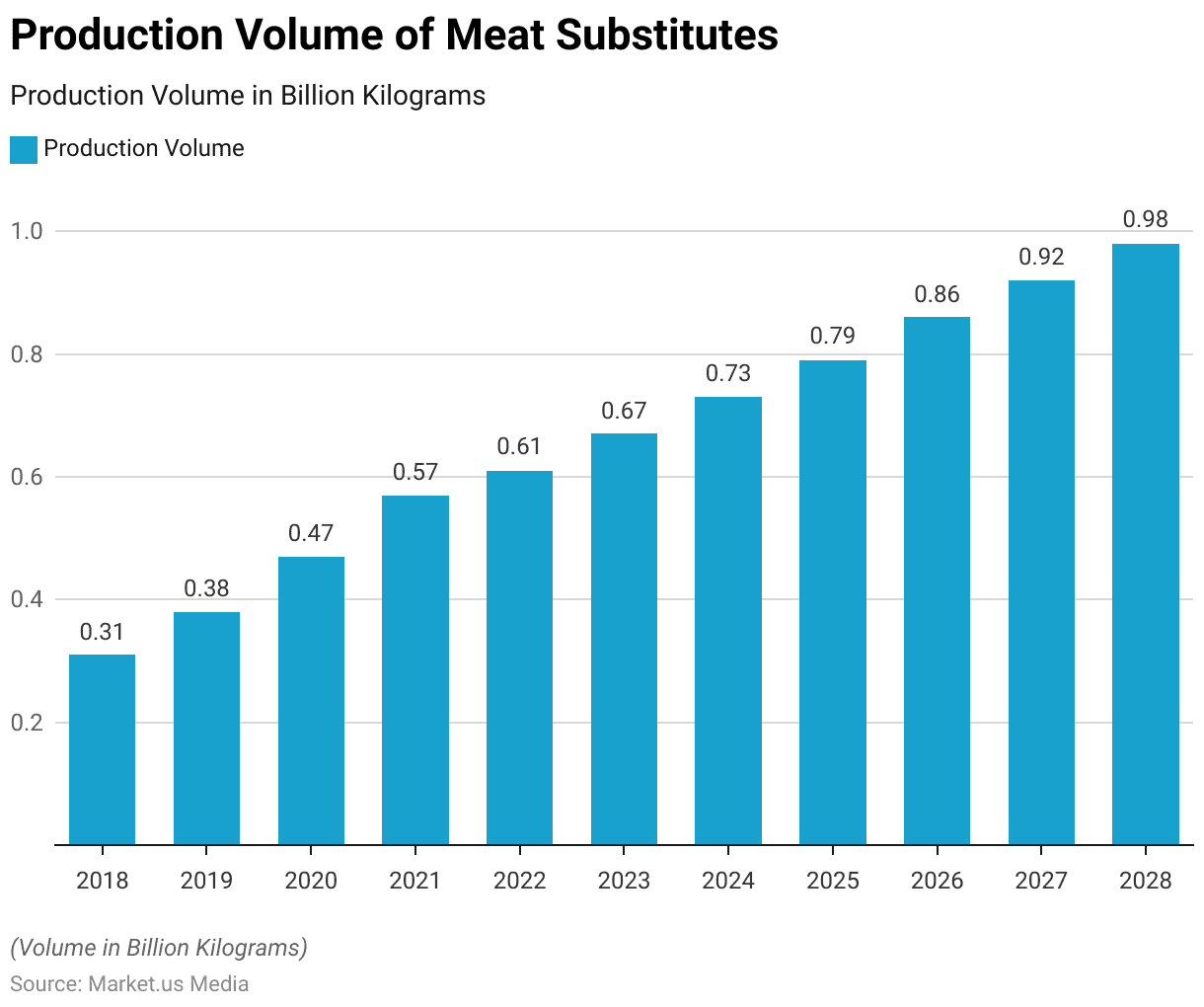
Price of Meat Substitutes
- Beginning at $15.06 in 2018, the price of meat substitutes slightly decreased to $14.16 in 2019 before remaining relatively stable at $14.10 in 2020.
- A slight decline continued in 2021 with a price of $13.77, followed by a modest increase to $14.66 in 2022.
- From 2023 onwards, a gradual uptrend is observed, with prices rising to $15.23 in 2023, $15.64 in 2024, and $16.00 in 2025.
- This trend persists with $16.36 in 2026, $16.72 in 2027, and $17.09 in 2028.

Leading Meat Substitute Brands Ranked by Brand Awareness
- In 2023, MorningStar Farms and Beyond Meat emerged as the leading meat substitute brands in the United States, with 56% and 54% of respondents indicating awareness of these brands, respectively.
- Impossible Foods, Amy’s Kitchen, and Gardein followed closely behind, each with significant brand awareness scores of 49%, 41%, and 41%, respectively.
- Other notable brands in the market included Boca (39%), Garden Gourmet (36%), and Tofurky (33%).
- While these brands commanded considerable consumer recognition, others such as Meatless Farm, Lightlife, and Sweet Earth Natural Food garnered attention, with awareness scores ranging from 30% to 29%.

Demographics of Plant-Based Meat Alternatives
According to Age
- Plant-based meat alternatives appeal to a diverse range of age groups, as evidenced by the distribution of consumption across various demographics.
- In 2023, individuals between the ages of 25 and 34 exhibited the highest level of engagement with plant-based meat alternatives, comprising 21% of consumers.
- Following closely behind were those aged 35 to 44, representing 18% of consumers, and individuals aged 45 to 54 and 55 to 64, each constituting 19% and 18% of the demographic, respectively.
- Furthermore, the age group of 65 and older displayed a notable interest in plant-based meat alternatives, accounting for 18% of consumers.
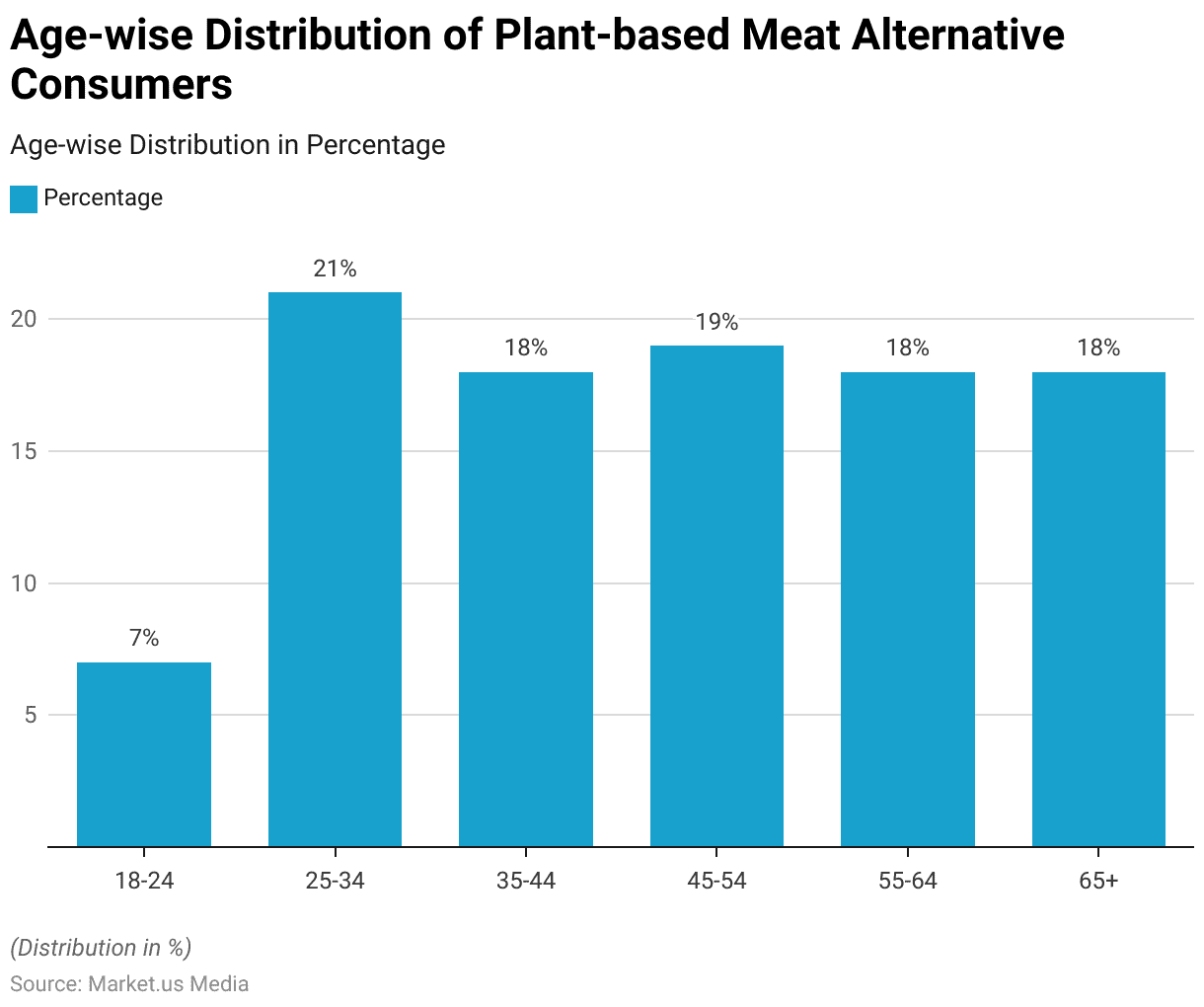
Accordingly Gender
- Plant-based meat alternatives exhibit a balanced distribution across gender demographics, with females and males showing nearly equal levels of engagement.
- In 2023, females accounted for 51% of consumers of plant-based meat alternatives, while males comprised 49%.

According to Education
- Plant-based meat alternatives exhibit varying levels of adoption across different education demographics.
- In 2023, individuals with a high school diploma represented the largest cohort of consumers, constituting 21% of the demographic.
- Close behind were those who had attended some college but did not attain a degree, comprising 20% of consumers.
- Additionally, individuals with an associate’s degree or technical/vocational school background accounted for 13% of consumers.
- Conversely, those with less than a high school education constituted the smallest group, representing only 1% of consumers.

Consumption Pattern of Plant-Based Meat Alternatives
- In the United States in 2023, the consumption patterns of plant-based meat alternatives varied among respondents, reflecting a spectrum of attitudes and behaviors towards these products.
- A small percentage, 7% of respondents, reported regularly consuming plant-based meat alternatives, indicating a consistent preference for these products.
- A more significant segment, comprising 34% of respondents, reported consuming plant-based meat alternatives in the past but not regularly.
- Additionally, 25% of respondents were open to plant-based meat alternatives despite never consuming them.
- However, a notable portion, 27% of respondents, indicated that they had never consumed plant-based meat alternatives and were not interested in trying them.

Advances in Meat Substitute Production Technologies
- Start-ups Redefine Meat and NovaMeat are pioneering 3D printing technology to craft intricate plant-based meat products, aiming to replicate the texture and appearance of traditional meats like steak and bacon.
- On the other hand, Atlast Food Co. and Meati are exploring an alternative method, utilizing mycelia to produce structured vegan meat analogs.
- Mycelia, the multicellular structures found in mushrooms, offer a sustainable and affordable option for mimicking the fibrous texture of meats like steaks and chicken breasts.
- At last, Food Co. cultivates large mycelial slabs for shaping into products like MyBacon, while Meati focuses on creating vegan “steaks” using mycelial.
Challenges Faced by the Meat Substitutes Industry
- According to survey findings, 40% of participants expressed reluctance to try cultivated meat, while 29% indicated a willingness to do so.
- Further analysis uncovered diverse perspectives on cultivated meats among various demographic segments.
- For instance, most baby boomers, accounting for 60% of respondents in this age group, stated their unwillingness to sample cultivated meat, contrasting sharply with only 27% of Gen Z individuals expressing a similar sentiment.
Discuss your needs with our analyst
Please share your requirements with more details so our analyst can check if they can solve your problem(s)



